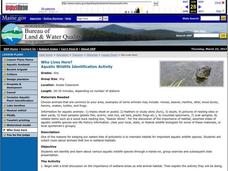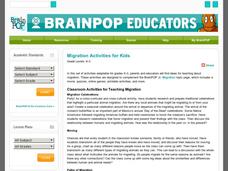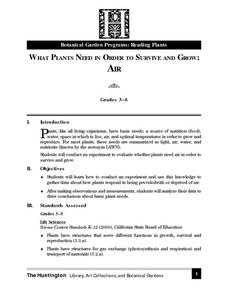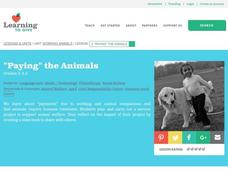Houghton Mifflin Harcourt
Animal Adventures: Extra Support Lessons (Theme 6)
This packet, the third in the series of support materials for the Houghton Mifflin Harcourt thematic units on animal adventures, contains skill-building activities designed for learners who need extra support mastering the concepts in...
Curated OER
Animals
Students become familiar with the need for categorizing scientific information, in this case, animals. They categorize the 5 groups of animals in a collage and answer questions about each.
Curated OER
Animal Shelter Service Project
Students complete a community service project. For this community service lesson, students discuss the needs of animals in animal shelters. They contact an animal shelter and help with one of these needs.
Curated OER
Singing for the Animals
Students examine the correct attitudes and poster for a concert. In this "Singing for Animals" lesson plan, students created charts to diagram information about the homeless animals they were singing for. Students used correct diction...
Curated OER
Animals A to Z: Koala
For this koala worksheet, 3rd graders will add pages to their "animal books." Students will read 10 facts about a koala locating 10 errors of punctuation, capitalization, spelling, and grammar while working toward gaining an...
Curated OER
Australia
Using their discussion notes Middle schoolers engage in a series of learning centers. Each center focuses on a different aspect of Australian geography, history, government, culture, and natural environment. Activities are briefly...
Curated OER
Who Lives Here?
Students identify various aquatic wildlife species. In this biology lesson students collect clues about animals that live in wetland habitats. Students rotate through several stations displaying particular animal species to collect their...
Curated OER
Water, Water Everywhere (Pond Animals)
Second graders examine the characteristics of animals who live in a pond environment. In groups, they describe the various stages in the life of a frog and identify the characteristics of other pond animals. Using this information,...
CK-12 Foundation
Properties of Multiplication in Decimal Operations: Balloon Animals
Commutive and associative properties are the focus of a five-question interactive. Dealing with decimal multiplication and addition, mathematicians solve multiple-choice and true or false questions using a model that moves balloons along...
Curated OER
What is a Puppy Mill?
Students consider community and legislative efforts to stop puppy mills. In this animal welfare lesson, students discuss the needs of pets and determine how puppy mills do not meet the needs of animals. Students research animal cruelty...
Curated OER
Wildlife Needs
Learners identify the wildlife needs in a specific setting. In this wildlife needs lesson plan, students identify and illustrate the four stages of forest succession. Learners list the natural habitat and food for a given species....
BrainPOP
Migration Activities for Kids
For as long as there has been life on earth, animals, including humans, have used migration as a means of survival. This collection of activities supports young scientists as they learn about this behavioral adaptation, encouraging them...
Curated OER
Grassland Animals
Third graders will be able to cut and paste from Internet into a word document with 100 percent accuracy. They use their research to write a 1-2 paragraph paper about their animal with 90 percent accuracy.
Curated OER
What Animals Need to Live
Fourth graders read "Habitat: What Animals Need to Live" then create a Venn diagram for herbivore, omnivore, and carnivore. In this animal survival lesson, 4th graders determine where different animals need to live depending on what they...
Curated OER
What Plants Need in Order to Survive and Grow: Air
Students conduct an experiment to determine whether plants need air in order to survive and grow. They discuss natural resources, analyze slides, and observe and record data from the experiment.
Curated OER
What Plants Need in Order to Survive and Grow: Soil
Students conduct an experiment to evaluate whether plants need soil to survive and grow. They plant two seeds, one with soil and one without, make predictions, and record and analyze the seed germination results on a worksheet.
Curated OER
Working Animals
Students examine the need for the humane treatment of animals. In this animal welfare instructional activity, students realize the need for animal welfare, and decide on a service project that will promote it. The instructional activity...
Curated OER
Sheltering and Caring for Animals
Students learn about animal shelters and adoption agencies. In this animal care lesson, students watch a video about the ASPCA and discuss what an animal shelter is, how it operates and what services it provides animals and the...
Curated OER
Introducing Working Animals
Students identify ways humans and animals work together. In this animal welfare lesson, students read the text Hanni and Beth: Safe and Sound and define the term "working animals." Students investigate working animals by visiting various...
Curated OER
Habitat is Home
Students complete a picture to show things found in their homes. In this habitat lesson, students discuss and make a class picture of an animal habitat and its four basic needs. Students sing a song. Students create their own habitat...
Smarter Balanced
Classifying Vertebrates
What features do scientists use to classify animals into groups? Class groups examine a series of paired images of vertebrates (a bass and a trout, a toad and a newt, a crocodile and a tortoise, an owl and a robin, a tiger and a bear)...
Curated OER
Force of Habitat
Plants and animals of the desert are the subject of this lesson. While the activities involve an exploration involving Nevada, this resource could be altered for use with any area. This detailed lesson includes a list of books that could...
American Museum of Natural History
Super Teeth
A brief comparison of human teeth versus animal teeth sets the stage for two worksheets. Scholars match a picture of a tooth-filled mouth to the animal to which it belongs and coloring pages featuring a different animal and informative...
Curated OER
Prairie Scavenger Hunt
Middle schoolers take a close look at the prairie environment. They identify common plants and animals of the prairie. In addition, pupils work in teams in order to put together a presentation on a certain aspect of the prairie...

























